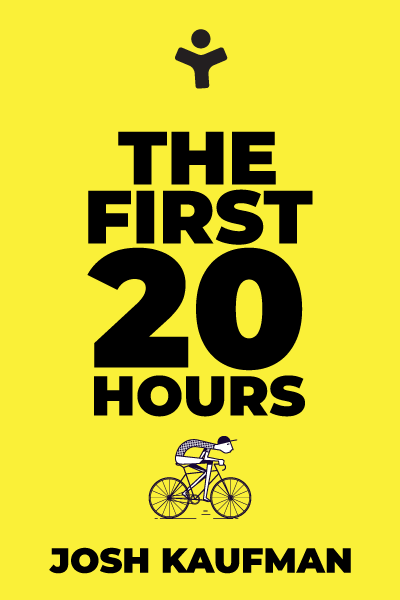
The First 20 Hours: How to Learn Anything...Fast
Read in the App
Full actionable summary
The First 20 Hours introduces the concept of rapid skill acquisition, a proven methodology that teaches you how to break down even the most complex skills into manageable parts, allowing you to overcome common learning barriers and achieve mastery in record time. The book emphasizes the crucial role of focused, deliberate practice in learning and provides practical tips and strategies to help you make the most out of your practice sessions. By following the proven techniques outlined in this book, you'll be able to increase your productivity, stay motivated, and achieve your learning goals faster than ever before!
What You'll Learn
This summary distills the key insights from The First 20 Hours: How to Learn Anything...Fast into actionable steps you can apply immediately. Perfect for busy professionals who want to learn and implement quickly.
Read in the App
Get the full actionable summary with our mobile app
Key Insights & Chapters
Rapid Skill Acquisition
To effectively learn a new skill, choosing the right approach is crucial. One such approach that has proven helpful is rapid skill acquisition.
Rapid skill acquisition involves breaking down a skill into its smallest parts and identifying the most important elements to practice first. By prioritizing the most crucial elements of the skill, learners can maximize their learning efficiency and avoid wasting time on less critical elements.
Furthermore, rapid skill acquisition relies on deliberate practice, which is more effective than inconsistent practice. Deliberate practice involves focused and intentional efforts to improve specific aspects of the skill.
Actions to Take
Focusing on a Few Important Moves
Rapid skill acquisition refers to the process of becoming an expert in a skill quickly by focusing on a few moves and repeating them.
Basically, the idea is that by focusing on a few key moves and repeating them, you can build muscle memory and become more efficient at performing the skill. But it's not just about mindlessly repeating the same thing over and over again - there are some specific strategies you can use to make the process more effective.
One of the most important things is to find a problem or project that you're really passionate about and use your skills to solve it. By doing this, you'll be more motivated to put in the time and effort required to become proficient in that skill. It's also important to focus on one skill at a time and define a target performance level so that you know what you're working towards.
Another key strategy is to deconstruct the skill into smaller parts. This can help you identify which subskills are the most important so that you can focus on them first. Additionally, you also need to use your willpower strategically. Rather than relying on it to consistently practice, it's better to use it to remove soft barriers that are preventing you from practicing that skill. Lastly, fast feedback is important for rapid skill acquisition, so try to integrate as many sources of feedback as possible.
Actions to Take
Making Yoga a Part of Your Routine
Yoga is an ancient practice that has been around for centuries for good reasons. It is a combination of breathing, movement, and meditation that has been known to improve physical and mental health.
Regular practice of yoga can help to reduce stress, improve flexibility, and build strength, which leads to an overall improvement in one's health and well-being.
Contrary to popular belief, practicing yoga is not just about flashy moves. There is a philosophical aspect to the practice that focuses on becoming a better person. This means that being a "real" yogi isn't about being able to assume Gumby-like positions but rather practicing in a way that helps you live a better life.
There has been some concern about the safety of yoga, with claims that it can lead to serious injuries. However, the yoga community has responded by stating that, statistically, yoga is safer than other physical activities. It all comes down to listening to your body, not forcing yourself into poses, and avoiding unnecessary pressure on the cervical spine. By taking these precautions, anyone can enjoy the benefits of yoga without any significant risk of injury.
Actions to Take
The Most Effective Method to Learning How to Play an Instrument
Playing a musical instrument can be a great way to relax and have fun. Additionally, research has shown that early exposure to music can have a positive impact on cognitive development.
To learn a musical instrument, there are three essential steps that a learner should follow.
The first step is isolation. This means focusing on one specific aspect of the instrument at a time. It could be a particular chord, scale, or even just a single note. By breaking down the instrument into smaller, more manageable pieces, you can learn and master each one more effectively.
The second step is practice. Once you've isolated a specific aspect of the instrument, the next step is to practice it repeatedly until you've mastered it. This could involve gradually progressing from simple to more complex techniques and committing to consistent practice sessions.
Finally, the third step is repetition. Once you've mastered an isolated aspect of the instrument, you should continue to practice and repeat the process until you've mastered the entire instrument. This helps reinforce muscle memory and ensures that you're comfortable with the instrument as a whole.
Actions to Take
Get Full Access in the App
Download Mentorist to explore detailed action steps, track your progress, and build lasting habits.